Found 26 talks archived in Catalogs and data

Abstract
AEGIS (All-wavelength Extended Groth strip International Survey: aegis.ucolick.org) is on-going survey that opens up new views of the development of galaxies and AGN's at redshifts z about 1. AEGIS is panchromatic like GOODS, with coverage ranging from X-ray to radio, and nearly as deep but more panoramic by covering a 4x larger region. Its backbone is the most Northern (accessible to the GTC) of the four fields of the DEEP2 Keck spectroscopic survey, which provides not only precision redshifts that yield reliable pairs, groups, and environments, but also internal kinematics and chemical abundances. After an overview of the DEEP and AEGIS surveys, I will share some recent highlights, including using a new kinematic measure for distant galaxies to track Tully-Fisher-like evolution; discovering metal poor, massive, luminous galaxies; finding ubiquitous galactic gas outflows among distant star forming galaxies; and exploring the nature of distant x-ray AGNs.
Abstract
The COSMOS survey is the largest high redshift galaxy evolution survey ever done -- imaging 2 square degrees with all major space-based and ground based observatories. I will describe the key data in the survey and then present recent results on large-scale structures, the dark matter distributions and galaxy evolution.
Abstract
SuperWASP is the UK's leading extra-solar planet detection program, having detected 22 of the 52 transiting planets known to date. This stems from the instruments ability to image ~500 square degrees every 60sec down to 16th mag (equivalent to the whole visible sky every 20 minutes). Recent experiments have shown that the data from SuperWASP can be reduced with 1 min of it being obtained and with further software development we will be able to identify transient sources within minutes of their observation. Detailed analysis of SuperWASP-N data has shown many populations of transient objects, including rapidly variable objects, which seem to correspond to extremely faint objects in the Sloan survey. Spectroscopy of these objects has proved challenging.
Abstract
The Virtual Observatory is an international initiative on standardizing astronomical data and protocols, as well as the development of scientific tools. Nowadays, the Virtual Observatory (VO) offers a number of powerful tools to manipulate and analyze catalogs, images, spectra and, of course, to inter-operate with the Virtual Observatory archives. In the SIE, we resume our SIEminar series, short and technical seminars, like this one in which Jorge will present the most interesting tools the Virtual Observatory offers.
Abstract
The plan of the Iranian National Observatory (INO) is to build within the next 5 years an active 3 meter telescope with a possible adaptive secondary on a mountain with more than 3000m height. We plan to have a remote-access and encourage the international community of astronomers to cooperate and to use up to 70% of the observing time. For the optical design and the first instruments we focus on few topics of astronomy. In the first part of my talk I will give a status report of this project and review the current proposals for the science case. In the second part of my talk I will introduce my own research interest and talk about the voids in the large scale structure of the universe. We have done studies on the systematics of void search algorithms in 2D galaxy samples, a 3D void analysis of the SDSS data release 6, and some approaches for theoretical modeling of the void properties and statistics. The Iranian National Observatory project and its science case
University of Sheffield, UK
Abstract
1) In this brief seminar (<~25 minutes+questions) I will present recent results on the study of "deep", high resolution, surface brightness profiles of a sample of ~500 late-type galaxies in the redshift range 0.1—1.1, making use of publicly available HST/ACS imaging of the GOODS-South field. We have classified and parameterized, according to usual prescriptions in this kind of analysis, these profiles, with special emphasis put on the so called ``truncated'' disks. This is the case in which, beyond a certain radius, termed as ``Break Radius'', the exponentially decaying surface brightness profile along the stellar disk gives way to an even more abrupt exponential decay. This radius can be taken as an spatial "scale" for the disk, as observed in a given band (in our case, the rest-frame B-band). Comparing with analogous analysis for galaxies in the Local Universe, as we have done, it is possible to extract valuable information on the evolution of several photometric properties of the stellar disks of galaxies, related to the stellar populations distributions. I will also present results on the analysis of the color profiles of this sample of galaxies, which have yield an interesting result which is, perhaps, the main reason that justifies calling this talk a "breaking news" seminar, as I will show. Summarizing, an overview of the results we have obtained will be given, and our conclusions on them, explaining how they can be understood in the frame of Galaxy Evolution (2) Based on high quality near-infrared spectroscopy (obtained with WHT/LIRIS) we reveal that the nucleus of Mrk 573 is an obscured Narrow-Line Seyfert 1 and not an archetypal Seyfert 2 as it has been classified until now. Currently only four AGNs have been classified into this category. We have detected permitted OI and FeII transitions, which indicates the existence of a high density region similar to the BLRs detected in type 1 AGN.
Upcoming talks
- TODAY: The effect of magnetic fields on galaxy evolution Dr. Enrique López-RodríguezThursday April 18, 2024 - 10:30 GMT+1 (Aula)
- EMO-1: Construyendo un observatorio caseroEnol Matilla BlancoFriday April 19, 2024 - 10:30 GMT+1 (Aula)








